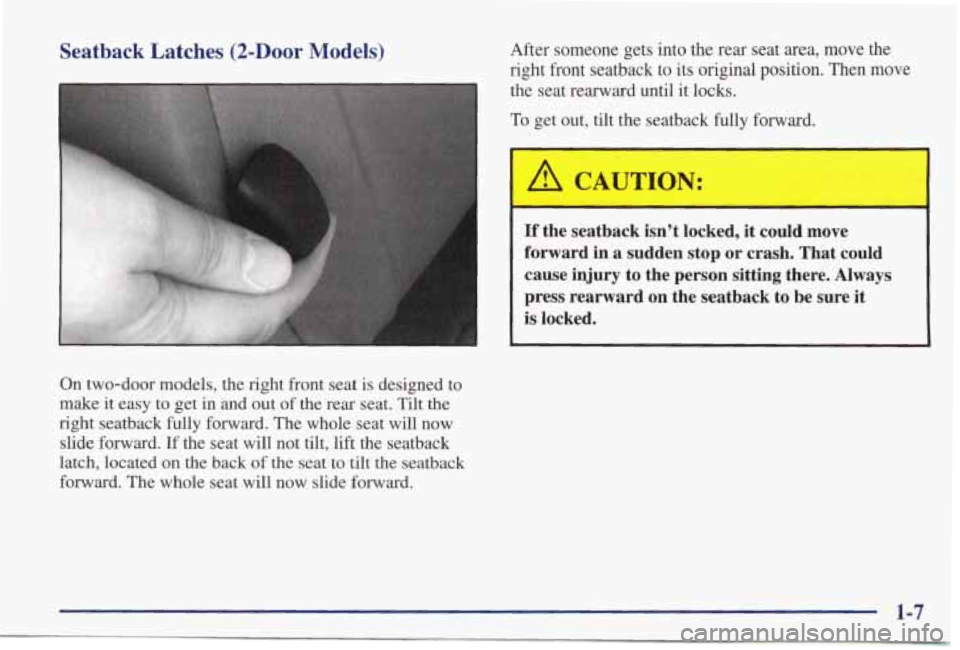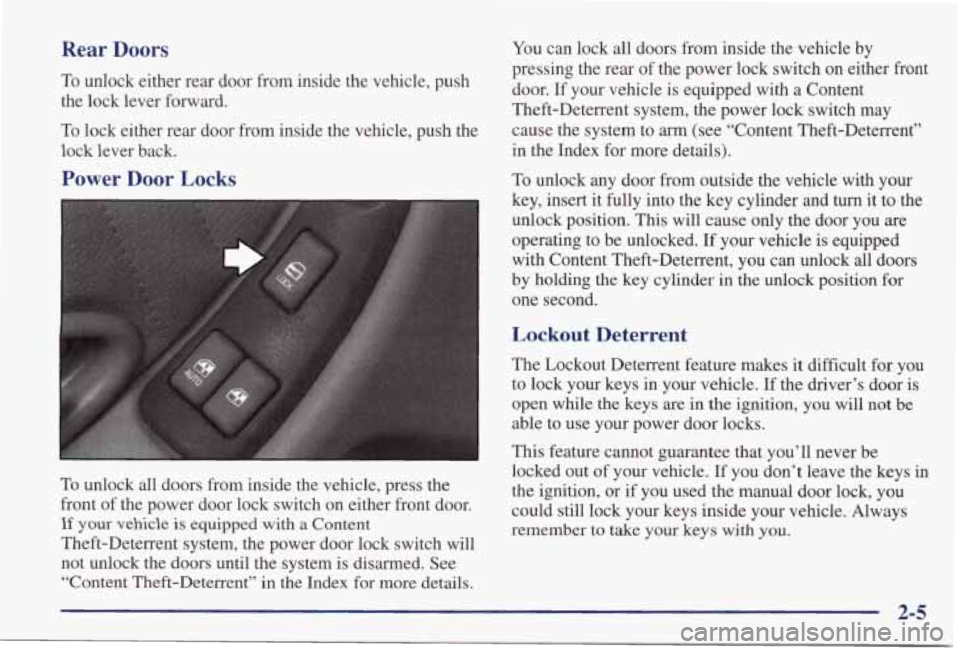1998 PONTIAC GRAND PRIX door lock
[x] Cancel search: door lockPage 14 of 402

Seatback Latches (2-Door Models)
On two-door models, the right front seat is designed to
make it easy to get in
and out of the rear seat. Tilt the
right seatback
fully forward, The whole seat will now
slide forward.
If the seat will not tilt, lift the seatback
latch, located
on the back of the seat to tilt the seatback
forward. The whole seat will now slide forward. After someone gets into
the rear seat area, move the
right front seatback to its original position. Then move
the seat rearward until it locks.
To get out, tilt the seatback fully forward.
A CAUTION:
If the seatback isn’t locked, it could move
forward in
a sudden stop or crash. That could
cause injury to the person sitting there. Always
press rearward on the seatback to be sure it
is locked.
1-7
Page 21 of 402

Driver Position
This part describes the driver’s restraint system.
Lap-Shoulder Belt
The driver has a lap-shoulder belt. Here’s how to wear
it properly.
1. Close and lock the door.
2. Adjust the seat (to see how, see “Seats” in the Index)
so you can sit up straight.
3. Pick up the latch plate and pull the belt across you.
Don’t let it get twisted.
The shoulder belt may lock
if you pull the belt across
you very quickly. If this happens, let the belt go back
slightly to unlock it. Then pull the belt across you
more slowly.
1-14
Page 23 of 402

Shoulder Belt Height Adjuster (4-Door Models)
Before you begin to drive, move the shoulder belt
adjuster to the height that is right for you.
To move it down, squeeze the release lever and move
the height adjuster
to the desired position. You can move
the adjuster up just
by pushing up on the shoulder belt
guide. After you move the adjuster to where you want
it,
try to move it down without squeezing the release lever
to make sure it
has locked into position.
Adjust the height
so that the shoulder portion of the
belt is centered
on your shoulder. The belt should be
away
from your face and neck, but not falling off
your shoulder.
1-16
Page 76 of 402

Section 2 Features and Controls
Here you can learn about the many standard and optional features on your vehicle, and inform\
ation on starting,
shifting and braking.
Also explained are the instrument panel and the warning systems that\
tell you if everything is
working properly
-- and what to do if you have a problem.
2-2
2-4
2-7
2-
12
2-13
2-14
2- 16
2-16
2-
17
2-20
2-2
1
2-26 2-27 2-30
Keys
Door Locks
Remote Keyless Entry System (If Equipped)
TrUnk
Theft
Content Theft-Deterrent (If Equipped)
New Vehicle “Break-In”
Ignition Positions
Starting Your Engine
Engine Coolant Heater
(If Equipped)
Automatic Transaxle Operation
Parking Brake Shifting Into PARK (P)
Shifting Out of PARK (P)
2-3 1
2-3 1
2-32
2-33
2-34
2-40
2-42
2-45
2-52
2-54
2-59
2-60
2-64
Parking Over Things That Burn
Engine Exhaust
Running Your Engine While You’re Parked
Power Windows
Turn SignaVMultifunction Lever
Exterior Lamps
Interior Lamps
Locks and Lighting Choices
Mirrors
Storage Compartments Sunroof
(If Equipped)
The Instrument Panel
-- Your
Information System
Warning Lights, Gages and Indicators
2-1
Page 78 of 402

The master key can be used
for the ignition, as well
as all door locks and
storage compartments.
The valet key can be used
for the ignition and the two
side doors only. It will not
open the
trunk, glove box or
fold down rear seat
trunk
access panel (if equipped). When a new vehicle
is delivered, it will come with
a bar
coded tag attached to the key ring.
This tag has a code on it that tells your dealer or
a
qualified locksmith how to make extra keys. Keep the
code in
a safe place. If you lose your keys, you’ll be able
to have new ones made easily using this code.
If you need a new ignition key, contact your dealer who
can obtain the correct key code. Remember to carry the
pre-cut emergency key which Pontiac sends after delivery.
(This service is not available in Canada.) In an
emergency, call Pontiac Roadside Assistance at
1-800-ROADSIDE or 1-800-762-3743. (In Canada call
1-800-268-6800.)
I 1
I NOTICE: I ~~
Your vehicle has a number of features that can
help prevent theft. But you can have a lot
of
trouble getting into your vehicle if you ever lock
your keys inside. You may even have to damage
your vehicle to get in.
So be sure you have
extra keys.
2-3
Page 79 of 402

Door Locks
1
I A CAUTION:
Unlocked doors can be dangerous.
Passengers
-- especially children -- can easily
open the doors and fall out. When
a door is
locked, the inside handle won’t open it.
Outsiders can easily enter through an unlocked
door
when you slow down or stop your vehicle.
This may not be so obvious: You increase the
chance of being thrown out of the vehicle in a
crash
if the doors aren’t locked. Wear safety belts
properly,
lock your doors, and you will be far
better off whenever you drive your vehicle.
There are several ways to lock and unlock your vehicle.
Front Door
To unlock either front door from outside the vehicle
with your key, insert it fully into the door key cylinder
and turn
it toward the front.
You can lock either front door from outside the vehicle
with your key
by inserting it fully into the door key
cylinder and
turning it toward the rear.
To unlock either front door from inside the vehicle, push
the lock lever forward.
To lock either front door from inside the vehicle, push
the lock lever back.
Page 80 of 402

Rear Doors
To unlock either rear door from inside the vehicle, push
the lock lever forward.
To lock either rear door from inside the vehicle, push the
lock lever back.
Power Door Locks
I
You can lock all doors from inside the vehicle by
pressing the rear of the power lock switch on either front
door. If your vehicle is equipped with a Content
Theft-Deterrent system, the power lock switch may
cause the system to
arm (see “Content Theft-Deterrent”
in the Index for more details).
To unlock any door from outside the vehicle with your
key, insert it fully into the key cylinder and
turn it to the
unlock position. This will cause only the door you are
operating to be unlocked. If your vehicle is equipped
with Content Theft-Deterrent, you can unlock all doors
by holding the key cylinder in the unlock position for
one second.
Lockout Deterrent
The Lockout Deterrent feature makes it difficult for you
to lock your keys
in your vehicle. If the driver’s door is
open while the keys are in the ignition, you will not be
able to use your power door locks.
This feature cannot guarantee that you’ll never be locked out of your vehicle. If you don’t leave the keys in
the ignition, or if you used the manual door lock, you
could still lock your keys inside your vehicle, Always
remember to take your
keys with you.
To unlock all dour-s from inside the vehicle, press the
front of the power door lock switch on either front door.
If your vehicle is equipped with a Content
Theft-Deterrent system, the power door lock switch will not unlock the doors until the system is disarmed. See
“Content Theft-Deterrent” in the Index for more details.
2-5
Page 81 of 402

To turn this feature on or off, see “Locks and Lighting
Choices” in the Index.
Last Door Closed Locking
The Last Door Closed Locking feature makes it more
convenient for you to use your power door locks
to lock
all the doors when leaving your vehicle. When any door is
open, the first time you attempt to lock
the doors using the
power door lock switch or remote remote keyless entry
transmitter will result
in three chimes to signal that Last
Door Closed Locking feature is being used.
All doors can
be opened for any reason for five seconds from the time
the last door has been closed. Five seconds
after the last
door
is closed, all doors will lock. You can lock the doors
immediately by using the power door lock switch or the
remote keyless
entry transmitter.
The Last Door Closed Locking feature will not occur
and doors will not be locked as a result of this feature
when the ignition switch is in RUN or ACCESSORY.
The Last Door Closed Locking feature is not enabled
from the factory.
To turn the Last Door Closed Locking feature on or off,
see “Locks and Lighting Choices” in the Index.
Automatic Door Locks
All of the doors will lock automatically when you move
your shift lever out of PARK
(P). All doors will unlock
automatically when the ignition is turned
off while the
shift lever is in PARK
(P). If you prefer to have your
doors unlocked automatically at
any time, see “Locks
and Lighting Choices” in the Index.
If someone needs to get in or out
of the vehicle after the
doors have been automatically locked, then place the
shift lever into PARK
(P). Unlock all doors by using the
power door lock switch or unlock just the door you want
by using the inside lever. If you have programmed your
automatic door locks (see “Locks and Lighting Choices’’\
in the Index) to unlock the doors when the shift lever is
shifted into PARK (P), then the doors will be
automatically unlocked
for you. The doors will
automatically lock when
you move your shift lever out
of PARK (P) with the ignition on.
If you don’t want the doors to unlock automatically
when you turn the ignition
off, see “Locks and Lighting
Choices” in the Index.
2-6